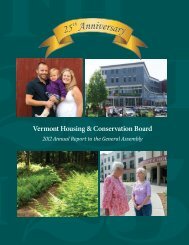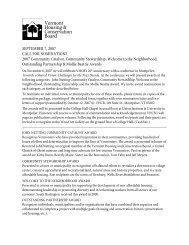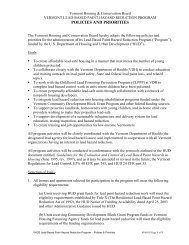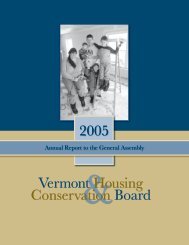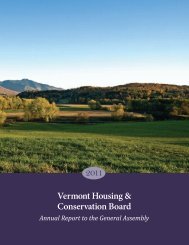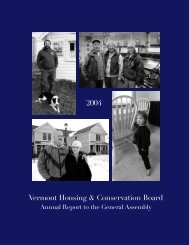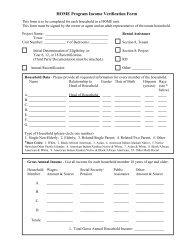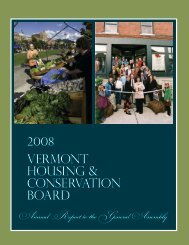9/17/2004 Vermont Housing and Conservation Board POLICY ...
9/17/2004 Vermont Housing and Conservation Board POLICY ...
9/17/2004 Vermont Housing and Conservation Board POLICY ...
You also want an ePaper? Increase the reach of your titles
YUMPU automatically turns print PDFs into web optimized ePapers that Google loves.
9/<strong>17</strong>/<strong>2004</strong><br />
<strong>Vermont</strong> <strong>Housing</strong> <strong>and</strong> <strong>Conservation</strong> <strong>Board</strong><br />
<strong>POLICY</strong><br />
FUNDING CONSERVATION OF AGRICULTURAL LAND<br />
Goal<br />
It is the intent of the State of <strong>Vermont</strong> to perpetually protect <strong>and</strong> preserve<br />
agricultural l<strong>and</strong>s, encourage sound soil management practices in accordance with<br />
generally accepted agricultural practices, preserve natural resources, maintain<br />
l<strong>and</strong> in active agricultural use <strong>and</strong> make reasonable efforts to assure that<br />
conserved farml<strong>and</strong> is accessible <strong>and</strong> affordable to future generations of farmers.<br />
To accomplish this goal, <strong>and</strong> to promote a strong agricultural economy, VHCB<br />
will give priority to farml<strong>and</strong> conservation projects in strong farming<br />
communities, support agricultural innovation <strong>and</strong> diversification, <strong>and</strong> encourage<br />
projects that facilitate intergenerational transfers.<br />
VHCB FARMLAND CONSERVATION ACTIVITIES<br />
The <strong>Vermont</strong> <strong>Housing</strong> <strong>and</strong> <strong>Conservation</strong> <strong>Board</strong> preserves farml<strong>and</strong> by:<br />
1. Awarding grants to eligible applicants (non-profit conservation organizations,<br />
municipalities, <strong>and</strong> qualified state agencies) for the purchase of development<br />
rights;<br />
2. Building the capacity of eligible applicants to do farml<strong>and</strong> conservation projects<br />
through capacity grants, <strong>and</strong> payment of costs associated with projects;<br />
3. Providing loans to eligible applicants for farml<strong>and</strong> acquisition or protection.<br />
The <strong>Board</strong> will fund a variety of preservation methods including, but not limited to,<br />
conservation easements, purchases, direct non-profit ownership with a lease, or resale, to the<br />
farmers, <strong>and</strong> l<strong>and</strong> swaps, as long as the result is the perpetual conservation <strong>and</strong> protection of<br />
agricultural l<strong>and</strong>.<br />
The primary farml<strong>and</strong> preservation activity of the <strong>Board</strong> is funding the purchase of<br />
development rights <strong>and</strong> placement of conservation restrictions on farml<strong>and</strong>. The<br />
conservation easement ensures that the l<strong>and</strong> will not be developed, while providing for uses<br />
compatible with farming.<br />
PROJECT SELECTION AND CONFIGURATION<br />
Minimum eligibility criteria for statewide farm projects:<br />
In order to qualify for VHCB agricultural funds, the l<strong>and</strong> to be conserved must meet the<br />
following criteria:
1. The farm or farml<strong>and</strong> must generally contain at least 50% prime <strong>and</strong>/or statewide<br />
soils, <strong>and</strong> be actively farmed for income-producing purposes, or have a sound<br />
plan for getting into operation. The property:<br />
a. must be a viable farm unit, or<br />
b. must be an addition to a conserved farm which adjoins, or is in close proximity to,<br />
the property, or,<br />
c. if farml<strong>and</strong> without associated infrastructure, must rank high enough in terms of<br />
soil resource, location, <strong>and</strong> management, as to indicate long-term, continued,<br />
active agricultural use.<br />
2. The project must conform to adopted regional <strong>and</strong>/or municipal plans.<br />
3. The sale price of the development rights must not exceed the value as determined by<br />
an appraisal acceptable to VHCB staff.<br />
4. The request to the <strong>Board</strong> (not including the value of the Option to Purchase at<br />
Agricultural Value or any other mechanism to achieve future affordability) shall not<br />
exceed One Thous<strong>and</strong> Seven Hundred Dollars ($<strong>17</strong>00) per acre for the development<br />
rights value on farml<strong>and</strong> unless there is substantial leverage <strong>and</strong> Four Hundred<br />
Thous<strong>and</strong> Dollars ($400,000) per project unless the farm is an Outst<strong>and</strong>ing<br />
Statewide Agricultural Resource as defined below. The VHCB limits are not project<br />
caps. (See Appendix II on VHCB per acre <strong>and</strong> per project caps for more<br />
information.)<br />
Except for criteria #4 above, this policy applies to all statewide <strong>and</strong> local farm projects.<br />
Locally Important farms must meet minimum eligibility criteria 1–3 above <strong>and</strong> comply with<br />
VHCB policy on Local <strong>Conservation</strong> Projects.<br />
Projects meeting these minimum criteria will be reviewed by a <strong>Board</strong> Committee advised by<br />
an Agricultural Advisory Committee based on the priorities listed below.<br />
SELECTION CRITERIA FOR STATEWIDE AND LOCALLY IMPORTANT<br />
FARM PROJECTS (listed in order of importance)<br />
Primary Considerations:<br />
1. L<strong>and</strong> Resource:<br />
a. Soils: Generally, all farm conservation projects will have at least 50% prime<br />
<strong>and</strong>/or statewide soils.<br />
b. Farmability: consideration will be given to the configuration <strong>and</strong> ease of farming<br />
the l<strong>and</strong>, including access, drainage, topography, location of excluded parcels, etc<br />
c. Potential for diversification: a higher priority will be given to l<strong>and</strong> that has a<br />
greater potential for diversified agricultural use, such as: ability of the soil to<br />
sustain a variety of agricultural uses, presence of a plentiful water supply,<br />
drainage, accessibility relative to direct marketing <strong>and</strong> transportation of products,<br />
<strong>and</strong> evidence of existing diversified uses.<br />
VHCB Policy on <strong>Conservation</strong> of Agricultural L<strong>and</strong> 5/7/<strong>2004</strong> 2
2. Location: (this criteria is not emphasized for Locally Important Farm projects)<br />
a. Adds to block of conserved l<strong>and</strong>: higher priority will be given to farms <strong>and</strong><br />
farml<strong>and</strong> that adjoin or are in close proximity to other conserved farml<strong>and</strong>.<br />
b. Strong farming community: factors such as the number of working farms,<br />
availability of agricultural support services, <strong>and</strong> the extent to which local planning<br />
or other municipal programs support farming will help to assess this factor.<br />
c. Development threat: the program will assess the degree of threat of the conversion<br />
of the farml<strong>and</strong> to non-farm use. Factors include: development opportunity<br />
(amount of road frontage <strong>and</strong> access, soil drainage, topography, <strong>and</strong> flood hazard,<br />
views, <strong>and</strong> proximity to utilities, <strong>and</strong> municipal water <strong>and</strong> sewer), <strong>and</strong> current<br />
market pressure.<br />
d. Suitability of the type of farming to the surrounding community will be assessed<br />
(e.g.. a market garden in a niche market area or a Community-Supported<br />
Agriculture (CSA) operation in a suburban area.)<br />
Secondary Considerations:<br />
3. Resource management: Sound resource management practices that maximize the<br />
long-term productivity of farml<strong>and</strong> will be assessed, including: drainage, erosion<br />
control, manure h<strong>and</strong>ling, crop rotation, stream bank improvement, wetl<strong>and</strong>s<br />
protection, <strong>and</strong> woodl<strong>and</strong> management.<br />
4. Farm Infrastructure: Condition <strong>and</strong> suitability of buildings for current or proposed<br />
farm operation: even when farm buildings are to be excluded from an easement, the<br />
buildings may play an important role in the viability of the farm operation, <strong>and</strong> will<br />
be evaluated in that context.<br />
PROJECT CONFIGURATION<br />
Goal: The configuration of agricultural conservation projects shall maximize the<br />
protection of important agricultural soils, promote the long term, economically viable use<br />
of the l<strong>and</strong> for agriculture, <strong>and</strong> include mechanisms that address <strong>and</strong> mitigate concerns<br />
over the affordability of the property to farmers in the future. (Tools to address future<br />
affordability are discussed below.)<br />
For farms that have buildings associated with them, particularly residences, VHCB will<br />
favor the “Farml<strong>and</strong>” configuration (i.e., excluding the infrastructure), unless the “Whole<br />
Farm” configuration includes an appropriate affordability mechanism.<br />
General Categories:<br />
• Whole farms – projects that include existing residences <strong>and</strong> farm infrastructure or<br />
reserved residential rights. Whole farms generally include at least 50% prime <strong>and</strong>/or<br />
statewide agricultural soils. Projects may be configured as Whole Farms when:<br />
VHCB Policy on <strong>Conservation</strong> of Agricultural L<strong>and</strong> 5/7/<strong>2004</strong> 3
• Allowing separate conveyance of the farml<strong>and</strong> <strong>and</strong> farmstead will make it<br />
unlikely that the farm will be owned <strong>and</strong> operated by a farmer in the future, (such<br />
as a farm that is not located in a strong farming community) or<br />
• The farmstead is in the middle of a tract of farml<strong>and</strong>, <strong>and</strong> excluding it would<br />
invite possible right-to-farm issues in the future, or<br />
• The farmstead includes historic or cultural resources important to the community.<br />
• The farmstead is uniquely related to the agricultural operation, such as a winery<br />
on a vineyard.<br />
• Add-ons to conserved farml<strong>and</strong> – projects that add parcels of farml<strong>and</strong> to previously<br />
conserved farms or farml<strong>and</strong>. These projects will generally include at least 50%<br />
prime <strong>and</strong>/or statewide agricultural soils, <strong>and</strong> must be in close proximity to the<br />
previously conserved farml<strong>and</strong>.<br />
• Farml<strong>and</strong> –projects that either exclude an existing farmstead (house <strong>and</strong> farm<br />
buildings) from the easement, or have no existing residential rights <strong>and</strong> little or no<br />
infrastructure associated with the property. Farml<strong>and</strong> projects do not include any<br />
residential rights in the easement. Farml<strong>and</strong> projects generally include at least 50%<br />
prime or statewide agricultural soils <strong>and</strong> a high level of farmability, which increase<br />
the likelihood of the l<strong>and</strong> being farmed well into the future, even without any<br />
associated residential rights or infrastructure. Farml<strong>and</strong> projects are also typically<br />
located in strong farming communities, where the long term need for productive l<strong>and</strong><br />
is more certain. Farml<strong>and</strong> parcels without nearby access to infrastructure will<br />
generally have a higher percentage of prime <strong>and</strong>/or statewide soils.<br />
• High “Estate” Risk Projects – the particular site characteristics, residential <strong>and</strong> farm<br />
improvements, or location of certain farms <strong>and</strong> farml<strong>and</strong> projects greatly increase the<br />
likelihood of estate conversion (views, the surrounding neighborhood, the proximity<br />
to other protected l<strong>and</strong>s or enhancing natural features such as surface water, or the<br />
market where the property is located). These farms, even as conserved, may be<br />
sought after as ‘gentleman’s farms’ by non-farmer buyers. In cases where the<br />
appraised highest <strong>and</strong> best use of the conserved property is sale into the estate market,<br />
the <strong>Board</strong> will likely require an Option to Purchase at Agricultural Value or other<br />
affordability mechanism (see below) on either the Whole Farm (as defined above) or<br />
Farml<strong>and</strong> as a condition of funding.<br />
FUTURE AFFORDABILITY OF CONSERVED FARMLAND<br />
Goal: The <strong>Board</strong> has adopted a policy goal, which includes making reasonable efforts to<br />
assure that conserved farml<strong>and</strong> is accessible <strong>and</strong> affordable to future generations of<br />
farmers. In addition, the <strong>Board</strong>’s goal includes encouraging intergenerational transfers<br />
that support owner/operated farm projects. This goal will be furthered through the<br />
appropriate application of the following tools during the configuration stage of each<br />
project.<br />
VHCB Policy on <strong>Conservation</strong> of Agricultural L<strong>and</strong> 5/7/<strong>2004</strong> 4
Affordability Tools:<br />
• Exclusion of Infrastructure – structural improvements on farm properties, especially<br />
residences, may contribute disproportionately to the market value of the farm, <strong>and</strong><br />
therefore will generally be excluded from the easement <strong>and</strong> made severable from the<br />
conserved l<strong>and</strong> in the interest of preserving the future affordability of the protected<br />
property. See Configuration Guidelines below for specific guidance on establishing<br />
farmstead exclusions.<br />
• Option to Purchase at Agricultural Value – in instances where infrastructure is<br />
included or where the removal of infrastructure alone will not control affordability,<br />
an Option to Purchase the protected property at Agricultural Value may be<br />
appropriate. All farm projects will be appraised both with <strong>and</strong> without the Option to<br />
Purchase at Agricultural Value unless specifically waived by VHCB staff. Farmers<br />
may then choose whether or not to accept an easement that includes the Option.<br />
Where the farmer chooses to accept it, the <strong>Board</strong> will usually approve the use of the<br />
Option. Furthermore, for projects with a high potential for estate conversion, as<br />
discussed above, the <strong>Board</strong> will usually require an Option or other suitable<br />
affordability mechanism as a condition of funding.<br />
• Shared Appreciation Agreement – Similar to the model developed by community<br />
l<strong>and</strong> trusts, the farmer <strong>and</strong> the Holders agree that, upon resale of the protected<br />
property, the farmer <strong>and</strong> the Holders would share any appreciation in the farm’s<br />
value, according to an agreed-upon formula. The Holders would then “reinvest” their<br />
share of the proceeds to reduce the sale price to the next buyer.<br />
• Nonprofit ownership of conserved farm with CLT approach to house - In some<br />
cases nonprofit conservation organizations may decide to purchase whole farms or<br />
farml<strong>and</strong>, convey a conservation easement to a qualified holder <strong>and</strong> lease the l<strong>and</strong> <strong>and</strong><br />
buildings to a farmer. In such a case, sustainable farming <strong>and</strong> affordability<br />
mechanisms can be built into the lease to insure affordable farming (perpetual access<br />
to the farml<strong>and</strong> by farmers) <strong>and</strong> resales of houses, if any, which are affordable to<br />
future farm households of moderate incomes.<br />
• Design Controls – for some projects, the <strong>Board</strong> may choose to include houses or<br />
rights for house sites, but condition the improvements (by limiting size, scale <strong>and</strong><br />
location) to make the protected property more affordable for future farmers.<br />
Grantees are encouraged to consider some or all of these mechanisms, alone or in<br />
combination, to further multiple goals <strong>and</strong> objectives. Grantees are also encouraged to<br />
work with VHCB staff to identify variations on these particular tools, or to develop new<br />
mechanisms that can address farm affordability effectively.<br />
VHCB Policy on <strong>Conservation</strong> of Agricultural L<strong>and</strong> 5/7/<strong>2004</strong> 5
CONFIGURATION GUIDELINES:<br />
Applicant procedure - Because existing <strong>and</strong> future housing <strong>and</strong> other reserved rights in the<br />
easement for farml<strong>and</strong> conservation projects affect easement value, it is the applicant's<br />
responsibility to obtain approval from VHCB staff for all exclusions, reserved house sites,<br />
<strong>and</strong> farm labor housing prior to the time that an appraiser is engaged. The size <strong>and</strong> location<br />
of all proposed excluded <strong>and</strong> reserved subdividable parcels <strong>and</strong> the location of all proposed<br />
farm labor house sites shall be clearly marked on an ortho-based 1:5000 scale map that is<br />
subject to VHCB staff review <strong>and</strong> approval prior to contracting with an appraiser. Once an<br />
appraisal map has been approved, no change of configuration shall be permitted without the<br />
consent of VHCB staff or <strong>Board</strong>.<br />
The applicant shall furnish a copy of the approved map to the appraiser, who shall include it<br />
in the appraisal report. The applicant shall also attach a copy of the map to the application<br />
form, <strong>and</strong> if the project is funded by the <strong>Board</strong>, the map shall become the basis of the farm<br />
plan approved by VHCB staff prior to disbursement of VHCB funds. Approval of an<br />
appraisal map by the staff should not be regarded by the applicant as pre-approval by the<br />
<strong>Board</strong> of any specific project configuration. If the <strong>Board</strong> asks for a reconfiguration as a<br />
condition of funding, additional appraisal work may be necessary.<br />
1. Excluding farmstead complexes:<br />
In determining the size of an excluded farmstead complex, consideration will be<br />
given to:<br />
a. Town zoning<br />
b. Future plans of the farmer (including farm labor housing needs)<br />
c. Soil quality (located to minimize impact on prime <strong>and</strong> statewide soils)<br />
d. Road frontage <strong>and</strong> access (may not include excessive road frontage, <strong>and</strong> may not<br />
prevent access to the conserved farml<strong>and</strong>).<br />
e. Ease of conducting a legal survey in the future<br />
f. Factors relating to the l<strong>and</strong>scape <strong>and</strong> its use.<br />
2. Non-subdividable Farmstead Exclusions:<br />
In rare cases, the <strong>Board</strong> may want to focus conservation restrictions on the farml<strong>and</strong>,<br />
but restrict the separate conveyance of the farmstead. This configuration will only be<br />
chosen when it appears to be the best option for conserving the farml<strong>and</strong> while<br />
meeting VHCB’s goals of maximizing protection of agricultural l<strong>and</strong>s <strong>and</strong> addressing<br />
future affordability concerns. (For example, a good farm resource in a community<br />
with few remaining farms, where the future use of the l<strong>and</strong> by a farmer without an<br />
associated house site <strong>and</strong> farm buildings may be unlikely.)<br />
3. Exclusions/reservations other than farmsteads:<br />
a. Future <strong>and</strong> existing house site exclusions: are excluded entirely from the easement,<br />
<strong>and</strong> subdividable from the protected property. These sites are generally no larger<br />
than 2 acres, or the minimum allowed by zoning, <strong>and</strong> are located:<br />
VHCB Policy on <strong>Conservation</strong> of Agricultural L<strong>and</strong> 5/7/<strong>2004</strong> 6
1. to avoid interruption of <strong>and</strong> minimize impact on farm fields, especially those<br />
with prime <strong>and</strong>/or statewide soils, <strong>and</strong> to avoid interference with agricultural<br />
operations; <strong>and</strong><br />
2. to maximize the agricultural potential <strong>and</strong> scenic <strong>and</strong>/or historic features of<br />
the protected property; <strong>and</strong><br />
3. in a cluster, rather than in a linear pattern along a roadway; <strong>and</strong><br />
4. close to or utilizing existing roads, drives, services <strong>and</strong> utilities.<br />
b. Future House site reserved exclusions: A designated future building area is<br />
identified ahead of time on the Farm Plan, <strong>and</strong> valued as such in the appraisal.<br />
When the l<strong>and</strong>owner wants to exercise his/her right to build, the area is surveyed<br />
<strong>and</strong> released from the easement. (See above, 3.(a) 1–4 for location criteria.)<br />
c. House Site Buy-Back: This agreement would allow a farmer to buy-back the<br />
right to build one, single-family house of a limited size in the future, if the<br />
conserved property did not include any housing, <strong>and</strong> the farmer could demonstrate<br />
that a house was necessary to operate a “st<strong>and</strong> alone” farm enterprise on the l<strong>and</strong>.<br />
This right would be appraised at the time of the sale of development rights, <strong>and</strong><br />
the appraisal would establish the value of the right, with a cost-of-living index<br />
adjustment. The future house, if built, would be non-subdividable, <strong>and</strong> would<br />
trigger an Option to Purchase at Agricultural Value on the whole farm, if one was<br />
not already in place. (See above, 3.(a) 1–4 for location criteria.<br />
d. Non-Agricultural l<strong>and</strong>: L<strong>and</strong>s without prime <strong>and</strong>/or statewide soils, that do not<br />
contribute to the economic viability of the farm operation <strong>and</strong> do not contain<br />
significant other values, may be excluded, provided that:<br />
1. potential development of l<strong>and</strong> excluded from the easement will have little or no<br />
negative impact on the conserved farming operation; <strong>and</strong><br />
2. the excluded portion is clearly depicted on the farm plan <strong>and</strong> reviewed <strong>and</strong><br />
approved by VHCB staff.<br />
e. L<strong>and</strong> in close proximity to a town or village center: L<strong>and</strong> that is near a village<br />
center <strong>and</strong> existing municipal services, may be excluded from an easement to<br />
accommodate future growth needs of the municipality.<br />
4. Linkage/Pre-approval of Subdivision<br />
Physically discrete parcels of l<strong>and</strong>, that either already have unique tax identification<br />
codes, or are geographically separated by a road, river, or other permanent boundary,<br />
that could be equally efficiently used independent of each other in the future, may be<br />
conserved under one easement that includes the future right to subdivide <strong>and</strong> convey<br />
the conserved parcels separately (with approval from the Holders) if:<br />
1. the parcels are located a distance from each other, <strong>and</strong> neither is dependent on<br />
the other for access, infrastructure, resource management, or other reasons; or<br />
2. either parcel qualifies as “barel<strong>and</strong>”, representing a valuable soils resource; or<br />
3. there is intention of future separation, at the time of conservation (such as to<br />
facilitate a planned inter-generational transfer).<br />
VHCB Policy on <strong>Conservation</strong> of Agricultural L<strong>and</strong> 5/7/<strong>2004</strong> 7
In such cases, the appraisal will include the valuation of the likely future<br />
subdivision.<br />
FUNDING PRIORITY<br />
The best projects recommended will be eligible for full review by the <strong>Board</strong> based on the<br />
above mentioned priorities.<br />
In addition, because the <strong>Board</strong> is charged with achieving the dual goals of creating<br />
affordable housing <strong>and</strong> preserving the state's agricultural l<strong>and</strong>, funding priority will be<br />
given to projects that combine the conservation of farml<strong>and</strong> with the development of<br />
affordable housing. These dual goals do not necessarily have to be on the same site. Also,<br />
farml<strong>and</strong> conservation projects which achieve VHCB's other goals of preserving natural<br />
areas <strong>and</strong> historic sites <strong>and</strong> providing or maintaining recreational opportunities may attain a<br />
higher relative ranking for funding.<br />
LEVERAGE FOR FARMLAND CONSERVATION PROJECTS<br />
The <strong>Board</strong> will seek to maximize the use of its limited funds by leveraging other resources<br />
for a project. The <strong>Board</strong> recommends that applicants attempt to secure leverage with all<br />
VHCB farm projects. Once a farm project has been analyzed <strong>and</strong> ranked under the four<br />
Farml<strong>and</strong> <strong>Conservation</strong> Priorities (L<strong>and</strong> Resource, Location, Farm Infrastructure,<br />
Management) as determined by the Agricultural Advisory Committee <strong>and</strong> the <strong>Board</strong><br />
Agricultural Committee, the amount <strong>and</strong> type of leverage may affect the relative ranking of<br />
the project. However, the <strong>Board</strong> may consider quality farm applications which were ranked<br />
highly by the Agricultural Advisory Committee but do not contain leverage. (See Appendix<br />
II for leverage criteria <strong>and</strong> definitions.)<br />
APPENDIX 1:<br />
SUMMARY OF APPLICATION PROCEDURES<br />
VHCB's Purchase of Development Rights on Farml<strong>and</strong> program involves a two-step<br />
application process: a pre-application <strong>and</strong> a full application. The <strong>Board</strong> accepts preapplications<br />
twice a year, <strong>and</strong> full applications several times a year, according to a schedule<br />
established each spring. Application deadline dates may be obtained by contacting VHCB<br />
staff.<br />
Pre-application forms are to be completed primarily by the l<strong>and</strong>owner, with assistance from<br />
an "eligible applicant" (see below). The pre-application assesses the farm resource, farm<br />
community <strong>and</strong> threat of development. It also asks for preliminary information on the other<br />
goals of the <strong>Board</strong> such as natural habitat protection, public outdoor recreation, historic<br />
preservation <strong>and</strong> affordable housing.<br />
The eligible applicant must also submit a cover letter with the pre-application that highlights<br />
notable facts about the property or further details other VHCB goals which may be included<br />
VHCB Policy on <strong>Conservation</strong> of Agricultural L<strong>and</strong> 5/7/<strong>2004</strong> 8
in the project. Since the <strong>Board</strong> will seek to maximize the use of its limited funds by<br />
leveraging other resources for a project, preliminary information on leveraging, if available,<br />
may also be included in the letter.<br />
Pre-Applications must be sponsored <strong>and</strong> submitted to the VHCB by an eligible applicant.<br />
An eligible applicant is a municipality, qualified department of state government, or nonprofit<br />
conservation organization with an IRS 501(c)(3) status. Eligible applicants for farm<br />
projects include the <strong>Vermont</strong> Agency of Agriculture (828-2500), the <strong>Vermont</strong> L<strong>and</strong> Trust<br />
(1-800-639-<strong>17</strong>09), a statewide non-profit l<strong>and</strong> conservation organization, <strong>and</strong> towns. Other<br />
eligible applicants include local or regional l<strong>and</strong> trusts, such as the Addison County<br />
Community L<strong>and</strong> Trust, the Hinesburg L<strong>and</strong> Trust, the Middlebury Area L<strong>and</strong> Trust, <strong>and</strong><br />
the Upper Valley L<strong>and</strong> Trust.<br />
Eligible applicants may submit to the VHCB all pre-applications that meet the <strong>Board</strong>'s<br />
Minimum Criteria <strong>and</strong> that are consistent with the <strong>Board</strong>’s Farml<strong>and</strong> <strong>Conservation</strong><br />
Priorities.<br />
The VHCB has established an Agricultural Advisory Committee (the "Advisory<br />
Committee") to assist the <strong>Board</strong> in choosing farms for conservation at the pre-application<br />
stage. The Advisory Committee consists of two farmers, one of whom has sold<br />
development rights, <strong>and</strong> one representative each from the UVM Extension Service, Natural<br />
Resources <strong>Conservation</strong> Service, Farm Service Agency, <strong>and</strong> one representative of a farm<br />
lending organization. Advisory Committee members are appointed by the Secretary of<br />
Agriculture with VHCB approval <strong>and</strong> subject to term limits set by the <strong>Board</strong>.<br />
The Advisory Committee makes recommendations to the VHCB Agricultural Committee<br />
(the "<strong>Board</strong> Committee"), prioritizing the farm pre-applications for funding. The <strong>Board</strong><br />
Committee decides which projects advance to full applications <strong>and</strong> which do not. Projects<br />
which receive an affirmative vote of the <strong>Board</strong> Committee are also eligible for a VHCB<br />
grant of 50% of the cost of an appraisal of a conservation easement on the property.<br />
Applicants will utilize an appraiser whose work conforms to the <strong>Board</strong>'s adopted appraisal<br />
st<strong>and</strong>ards to determine the fair market value of the development rights. Applicants will<br />
negotiate a price acceptable to the l<strong>and</strong>owner, <strong>and</strong> the <strong>Board</strong>'s contribution will not exceed<br />
the appraised value or the <strong>Board</strong> cap (see last section, below).<br />
Applicants will also work with l<strong>and</strong>owners to explore the other goals of the <strong>Board</strong> that may<br />
exist on the farm, <strong>and</strong> the potential for leverage.<br />
Farm pre-applications that are not approved by the <strong>Board</strong> Committee are eligible to return as<br />
pre-applications <strong>and</strong> may be considered by the Advisory Committee in the next preapplication<br />
round. However, a pre-application that returns in this manner <strong>and</strong> is not<br />
approved a second time is not eligible to return again in the next pre-application round. A<br />
pre-application in this category may return after waiting out one round of the Advisory<br />
Committee.<br />
VHCB Policy on <strong>Conservation</strong> of Agricultural L<strong>and</strong> 5/7/<strong>2004</strong> 9
To be considered by the full <strong>Board</strong>, approved pre-applications must be submitted as full<br />
applications by the date set by VHCB staff. If an approved pre-application is not submitted<br />
as a full application within two years of being approved as a pre-application, the project<br />
must return to the pre-application process <strong>and</strong> be reviewed by the Advisory Committee. If<br />
staff determines that extenuating circumstances prevented the timely submission of a full<br />
application, VHCB staff may grant an exception to this procedure. To receive such an<br />
extension, the applicant organization must have received written approval from VHCB staff<br />
prior to the last application deadline for which the project would have been submitted if an<br />
extension had not been granted.<br />
Full applications will be reviewed by the full <strong>Board</strong> with a final decision made based upon<br />
the recommendations of the <strong>Board</strong> Committee, price/acre, leverage <strong>and</strong> the multiple benefits<br />
of the project.<br />
A full application that the <strong>Board</strong> has voted not to fund is eligible to return as a full<br />
application at the next <strong>Board</strong> meeting. If the application is not submitted in time for<br />
consideration at that meeting or if the <strong>Board</strong> again votes not to fund the full application, the<br />
project must return to the normal pre-application process.<br />
The VHCB staff may waive these procedures if the applicant <strong>and</strong> l<strong>and</strong>owner demonstrate<br />
extenuating circumstances in support of a waiver.<br />
APPENDIX II: VHCB FUNDING CAPS<br />
VHCB PER PROJECT CAP<br />
VHCB will not pay more than $400,000 for the development rights on farml<strong>and</strong> unless<br />
the farm is an outst<strong>and</strong>ing statewide resource. This cap does not apply to the Option to<br />
Purchase at Agricultural Value, or other affordability mechanism.<br />
To be eligible for consideration as an “Outst<strong>and</strong>ing Statewide Agricultural Resource” a<br />
farm must fulfill the following requirements:<br />
1. As compared to other farms in the same funding round <strong>and</strong> farms previously<br />
conserved by VHCB, the farm ranks high under the “L<strong>and</strong> Resource”, “Farm<br />
Infrastructure” <strong>and</strong> “Management” criteria of the Farml<strong>and</strong> <strong>Conservation</strong> Priorities.<br />
2. <strong>Conservation</strong> of the farm would make a significant contribution to the local <strong>and</strong>/or<br />
regional farm community.<br />
3. <strong>Conservation</strong> of the farm would serve multiple goals because the project includes one<br />
or more substantial enhancements within the following categories:<br />
a. an outst<strong>and</strong>ing historical or archeological resource<br />
b. public access meaningful to the community<br />
c. significant natural habitats or ecological resources<br />
VHCB Policy on <strong>Conservation</strong> of Agricultural L<strong>and</strong> 5/7/<strong>2004</strong> 10
d. donation of conservation easements or l<strong>and</strong>s into public ownership with<br />
significant non-agricultural natural resource, public recreation, or historic values<br />
e. the farm adjoins <strong>and</strong>/or would significantly enhance an existing public investment<br />
in other non-agricultural natural resource l<strong>and</strong>s owned or conserved by a public<br />
or non-profit entity<br />
f. a buffer provision that complies with VHCB Buffer Policy in the easement would<br />
conserve the quality of significant state surface waters.<br />
g. inter-generational transfer of the farm<br />
VHCB staff <strong>and</strong> <strong>Board</strong> may use the above criteria to determine if a farm is eligible for<br />
funding moderately beyond the stated cap. However, large projects which exceed the cap<br />
substantially will continue to need to be conceived of <strong>and</strong> funded in stages.<br />
VHCB PER ACRE CAP<br />
The <strong>Board</strong> will not pay more than $<strong>17</strong>00/acre for development rights on farml<strong>and</strong> (not<br />
including the Option to Purchase at Agricultural Value, or other affordability mechanism)<br />
unless there is substantial leverage, in which case the <strong>Board</strong> may at its discretion pay more<br />
than $<strong>17</strong>00/acre. Substantial leverage is defined as follows:<br />
- Meets at least two of the criteria in the "High" category<br />
- More than 40% of the total project costs contributed by a town, other state or federal<br />
programs, private fundraising or bargain sale<br />
- Meets one criteria in the "High" category <strong>and</strong> two criteria in the "Medium" category<br />
- Leverage in the "Low" category will not be considered eligible for meeting the<br />
substantial category<br />
The <strong>Board</strong> will evaluate leverage based on the following list, <strong>and</strong> may consider other forms<br />
of leverage not on the list at its discretion. A project must meet at least one criterion in a<br />
category to be eligible for the designated category.<br />
High<br />
- Matching funds of more than 15% of the total project costs contributed by a town<br />
- Matching funds of more than 20% of the total project costs contributed by a state or<br />
federal programs or private fundraising<br />
- More than 20% of the total project costs matched with the donation of l<strong>and</strong> or<br />
conservation easements on adjoining or nearby l<strong>and</strong>s that would enhance the<br />
purpose of the project<br />
VHCB Policy on <strong>Conservation</strong> of Agricultural L<strong>and</strong> 5/7/<strong>2004</strong> 11
- The donation of l<strong>and</strong> on an appropriate site in the town for affordable housing where<br />
the need has been identified <strong>and</strong> an appropriate eligible applicant has expressed an<br />
interest in developing the site sometime in the future<br />
- A bargain sale by the l<strong>and</strong>owner of more than 20% of the value of the conservation<br />
easement by an appraisal or the value set by the Farml<strong>and</strong> Investment Program<br />
- Project meets at least two of the medium criteria<br />
Medium<br />
- Matching funds of 8%-15% of the total project costs contributed by a town<br />
- Matching funds of 10%-20% of the total project costs contributed by a state or<br />
federal programs or private fundraising<br />
- 10%-20% of the total project costs matched with the donation of l<strong>and</strong> or<br />
conservation easements on adjoining or nearby l<strong>and</strong>s that would enhance the<br />
purpose of the project<br />
- A bargain sale by the l<strong>and</strong>owner of 10%-20% of the value of the conservation<br />
easement<br />
- The donation of an easement for public recreational access to water (if not<br />
compensated for in the conservation easement value)<br />
- A 50% bargain sale of an appropriate site in the town for affordable housing where<br />
the need has been identified <strong>and</strong> an appropriate eligible applicant has expressed an<br />
interest in developing the site sometime in the future<br />
- The donation of appropriate l<strong>and</strong> in town for a natural area protection, public<br />
recreation or historic preservation purposes<br />
- The donation of a public access trail easement (if not compensated for in the<br />
conservation easement value) if it is part of a community/regional trail network<br />
- Project meets at least three of the low criteria<br />
Low<br />
- 3%-8% of the total project costs contributed by the town<br />
- 5%-10% of the total project costs contributed by the town, other state or federal<br />
programs or private contributions<br />
- 5%-10% of the total project costs matched with the donation of l<strong>and</strong> or conservation<br />
easements on adjoining or nearby l<strong>and</strong>s that would enhance the purpose of the<br />
project<br />
VHCB Policy on <strong>Conservation</strong> of Agricultural L<strong>and</strong> 5/7/<strong>2004</strong> 12
- A bargain sale by the l<strong>and</strong>owner of 5%-10% of the value of the conservation<br />
easement<br />
- The substantial donation of in-kind professional services<br />
- The donation of a public access trail easement (if not compensated for in the<br />
conservation easement value)<br />
- The donation of an historic preservation covenant (Outst<strong>and</strong>ing Historic Resources<br />
Clause) requiring l<strong>and</strong>owner notification prior to demolishing or altering an<br />
outst<strong>and</strong>ing historic resource or an historic resource on or eligible for the National<br />
Register of Historic Place.<br />
[In some farml<strong>and</strong> conservation projects that contain a building on or eligible for the<br />
National Register of Historic Places or is considered an outst<strong>and</strong>ing historic resource, the<br />
<strong>Board</strong> may require that an historic preservation notification provision be incorporated into<br />
the conservation easement. Such a provision will require that the l<strong>and</strong>owner notify the<br />
Grantees 30 days prior to destroying or altering the exterior of the building. In determining<br />
whether a building is an outst<strong>and</strong>ing resource, the <strong>Board</strong> shall give serious consideration to<br />
the recommendation of the Division for Historic Preservation.]<br />
VHCB Policy on <strong>Conservation</strong> of Agricultural L<strong>and</strong> 5/7/<strong>2004</strong> 13



